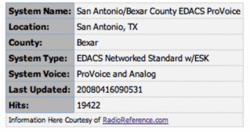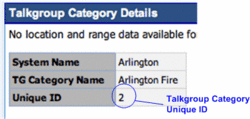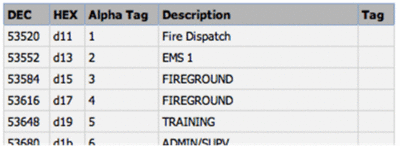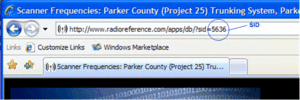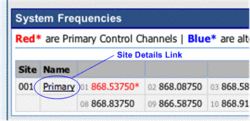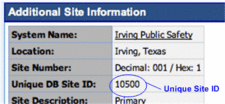Difference between revisions of "RR Javascript remote render service"
From The RadioReference Wiki
| Line 8: | Line 8: | ||
<br /> | <br /> | ||
| − | 2. Wait for your domain key to be approved by the administration staff | + | 2. Wait for your domain key to be approved by the administration staff my key is me |
| − | |||
| − | |||
=== Data available for remote rendering === | === Data available for remote rendering === | ||
Revision as of 14:51, 20 March 2024
The RadioReference Javascript remote render service allows web designers and web page developers to integrate data from the radioreference.com database into their own Web pages.
Contents
Steps for using the Javascript remote render service
1. Apply for a domain key at the following page on your account settings page:
2. Wait for your domain key to be approved by the administration staff my key is me
Data available for remote rendering
Frequency Subcategory
You can display a frequency subcategory on a Web page by adding the following code to the page:
<script language="JavaScript" src="https://api.radioreference.com/js/?key=DOMAIN_KEY&scid=SUBCAT_ID"> </script>
- DOMAIN_KEY = Your uniquely assigned and active domain key
- SUBCAT_ID = The unique radioreference.com subcategory ID. This can be found by clicking the subcategory additional details icon for a subcategory. See below:
For example, to display the Comal County Fire SO frequency subcategory on a page, you would add the following code:
<script language="JavaScript" src="https://api.radioreference.com/js/?key=12345678&scid=195"> </script>
The following would be displayed on the Web page where the code was inserted:
Trunked Radio System Information
You can display a trunking system's general information on a Web page by adding the following code to the page:
<script language="JavaScript" src="https://api.radioreference.com/js/?key=DOMAIN_KEY&sid=SID"> </script>
- DOMAIN_KEY = Your uniquely assigned and active domain key
- SID = The unique radioreference.com trunked system system identifier. This can be found by viewing the URL for the trunked system. See below:
For example, to display the Bexar County / San Antonio EDACS system's general information, you would include the following code on your page:
<script language="JavaScript" src="https://api.radioreference.com/js/?key=12345678&sid=1434"> </script>
The following would be displayed on the Web page where the code was inserted:
Talkgroup Category
You can display a talkgroup category's talkgroups on a Web page by adding the following code to the page:
<script language="JavaScript" src="https://api.radioreference.com/js/?key=DOMAIN_KEY&tgCid=TGCAT_ID"> </script>
- DOMAIN_KEY = Your uniquely assigned and active domain key
- TGCAT_ID = The unique radioreference.com talkgroup category ID. This can be found by clicking the talkgroup category additional details icon. See below:
For example, to display the City of Arlington's Fire Department Talkgroups from the Arlington Trunked System, you would add the following code:
<script language="JavaScript" src="https://api.radioreference.com/js/?key=12345678&tgCid=2"> </script>
The following would be displayed on the Web page where the code was inserted:
Trunked System Complete Talkgroup List
You can display all talkgroups for a trunking system on a Web page by adding the following code to the page:
<script language="JavaScript" src="https://api.radioreference.com/js/?key=DOMAIN_KEY&sidalltg=SID"> </script>
- DOMAIN_KEY = Your uniquely assigned and active domain key
- SID = The unique radioreference.com trunked system system identifier. This can be found by viewing the URL for the trunked system.
For example, to display all talkgroups for the Parker County TX Trunking system , you would add the following code to your page:
<script language="JavaScript" src="https://api.radioreference.com/js/?key=12345678&sidalltg=5636"> </script>
The following would be displayed on the Web page where the code was inserted:
Trunked System Site with Frequencies
You can display a individual trunked system site with frequencies on a Web page by adding the following code to the page:
<script language="JavaScript" src="https://api.radioreference.com/js/?key= DOMAIN_KEY&siteId=SITE_ID"> </script>
- DOMAIN_KEY = Your uniquely assigned and active domain key
- SITE_ID = The unique radioreference.com siteId. This can be found by clicking the site description link for a trunked system site. See below:
For example, to display the trunked system site for the Irving TX Public Safety Trunking System, the following code would be used:
<script language="JavaScript" src="https://api.radioreference.com/js/?key=12345678&siteId=10500"> </script>
The following would be displayed on the Web page where the code was inserted:
All Trunked System Sites
You can display all trunked system sites with frequencies on a Web page by adding the following code to the page:
<script language="JavaScript" src="https://api.radioreference.com/js/?key= DOMAIN_KEY&sites=SID"> </script>
- DOMAIN_KEY = Your uniquely assigned and active domain key
- SID = The unique radioreference.com trunked system system identifier. This can be found by viewing the URL for the trunked system.
For example, to display all trunked system sites for the San Antonio TX Public Safety Trunking System, the following code would be used:
<script language="JavaScript" src="https://api.radioreference.com/js/?key=12345678&sites=1434"> </script>
Customizing the Width of Tables
Adding the following to any method query will allow you to customize the width of the table(s) returned by the method (does not apply to audio feed method)
&width=100%
or
&width=500px




